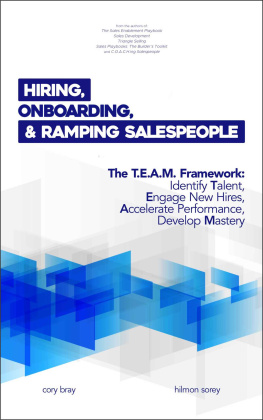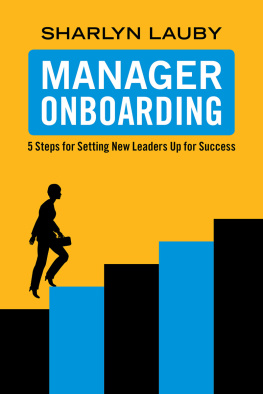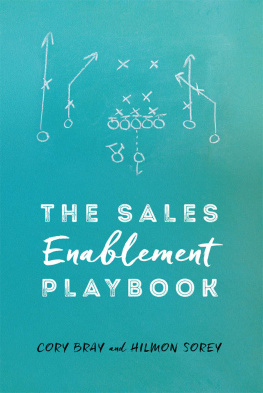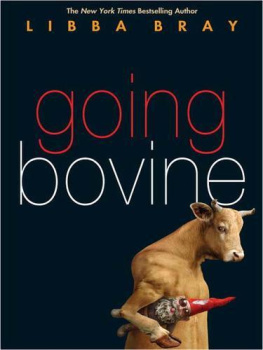Cory Bray - Hiring, Onboarding, and Ramping Salespeople: The T.E.A.M. Framework
Here you can read online Cory Bray - Hiring, Onboarding, and Ramping Salespeople: The T.E.A.M. Framework full text of the book (entire story) in english for free. Download pdf and epub, get meaning, cover and reviews about this ebook. year: 2019, publisher: Open-Source Publishing, genre: Home and family. Description of the work, (preface) as well as reviews are available. Best literature library LitArk.com created for fans of good reading and offers a wide selection of genres:
Romance novel
Science fiction
Adventure
Detective
Science
History
Home and family
Prose
Art
Politics
Computer
Non-fiction
Religion
Business
Children
Humor
Choose a favorite category and find really read worthwhile books. Enjoy immersion in the world of imagination, feel the emotions of the characters or learn something new for yourself, make an fascinating discovery.
- Book:Hiring, Onboarding, and Ramping Salespeople: The T.E.A.M. Framework
- Author:
- Publisher:Open-Source Publishing
- Genre:
- Year:2019
- Rating:3 / 5
- Favourites:Add to favourites
- Your mark:
- 60
- 1
- 2
- 3
- 4
- 5
Hiring, Onboarding, and Ramping Salespeople: The T.E.A.M. Framework: summary, description and annotation
We offer to read an annotation, description, summary or preface (depends on what the author of the book "Hiring, Onboarding, and Ramping Salespeople: The T.E.A.M. Framework" wrote himself). If you haven't found the necessary information about the book — write in the comments, we will try to find it.
Cory Bray: author's other books
Who wrote Hiring, Onboarding, and Ramping Salespeople: The T.E.A.M. Framework? Find out the surname, the name of the author of the book and a list of all author's works by series.
Hiring, Onboarding, and Ramping Salespeople: The T.E.A.M. Framework — read online for free the complete book (whole text) full work
Below is the text of the book, divided by pages. System saving the place of the last page read, allows you to conveniently read the book "Hiring, Onboarding, and Ramping Salespeople: The T.E.A.M. Framework" online for free, without having to search again every time where you left off. Put a bookmark, and you can go to the page where you finished reading at any time.
Font size:
Interval:
Bookmark:
The T.E.A.M. Framework
BY CORY BRAY AND HILMON SOREY
FOREWORD BY DAVID BLOOM
AFTERWORD BY JODI MAXSON
Copyright 2019 Cory Bray and Hilmon Sorey
All rights reserved.
ISBN 13: 9781706730989
The evolution of modern sales is rarely sparked by a truly new idea.
Mobile phones didnt invent selling on the go, any more than CRM invented customer relationship management or dialers invented the cold call.
Sales onboarding is no different.
People have been looking to make sales reps better at their jobs ever since the first caveman sales manager got his first caveman direct report. Weve just evolved.
First, we had sales methodologies. Then, a CRM. Then RevOps, sales training, proper coaching, and readiness programs specifically for go-to-market teams.
Now, its time for sales enablement to takes its place where it belongsa strategic business function that improves top-line revenue and bottom-line growth by maximizing sales rep profitability.
Rep profitability should be the north star for leaders in charge of making new hires successful. And the #1 way to do that is to reduce ramp time.
Dont get me wrongevery salesperson goes through some sort of period where they are getting up to speed. Zero to quota in sixty seconds or less is an insane pipedream. But, rather than cramming onboarding into a one or two week boot camp, we should design programs that reflect the experience of the reps that were onboarding.
Now normally, forewords dont have graphs, but hey, Im a maverick. Take a look at the graph in . Salespeople transition through what I call the J-curveat first unprofitable for the business as they learn, and then delivering increasing value over time as they hit their sales milestones, like first activity, first meeting, first pipeline, first deal, first quota, and first consistent quota.
Figure 0.1: The J-curve for sales rep productivity

If our goal is to improve rep profitability, then we need to onboard and ramp faster. We need to cut the curve and shift the whole thing left, hitting each sales milestone sooner to achieve sales objectives earlier. After all, it doesnt take a rocket scientist to know that if salespeople find pipeline faster, theyll get their first deal faster. If they can book a meeting in week two instead of week three, theyll probably get to pipeline in week four instead of week five.
And if we can embed these milestones directly into programs, we can optimize those programs over time, giving teams a clear mandate for onboardingif a program isnt impacting the time to a specific milestone, then the program shouldnt exist.
Imagine: instead of looking at vanity metrics like quiz scores and how much content gets consumed, what if we focused on the outcomes of our programs?
What if whoevers leading onboarding could definitively prove how much revenue the company realized for every dollar they put into their programs? Because I know one thing for sureif theyre going to get a seat at the table, they had better have the numbers more meaningful than certification metrics. No VP Sales ever walks into the boardroom and says: Hey, great news! We all missed our number, but quiz performance is up 22%!
No. If you want to be taken seriously, you need to move the metrics that matter and generate the revenue outcomes that executives care about.
Think back to the Kirkpatrick Model. For years weve been so focused on reaction and learning at the bottom that weve forgotten about the outcomes were supposed to drive at the top: the behavior and results that matter most to sales leaders.
Salespeople want to know that their enablement team understands what it takes for them to be successful. They need to understand both the outcomes being driven, and that the outcomes being driven matter to them.
When we talk about outcomes instead of inputs and quotas instead of quizzes, I call it outcome-based enablement. Its the next evolution of the readiness function.
If we can tie program inputs to revenue outcomes, then hire, onboard, and ramp against those outcome success metrics, we can elevate the profession from a tactical component of the RevOps toolkit to a strategic business function thats critical to success. Management will finally have a quantifiable answer to the question Are my reps getting better, faster, and if so, why?
This story will always start with hiring, onboarding, and rampingand Cory and Hilmon have developed a complete strategic and tactical guide for leaders who are in the trenches. They explain not only what leaders should be doing in terms of onboarding and ramping to pivot the function toward real outcomes, but they get into the details of how to get it done.
Cory and Hilmon turn their countless consulting hours into an indispensable handbook on how to build a repeatable hiring, onboarding, and ramping enginean engine that can (and should!) be an essential component of any growth machine.
Enablement isnt a new idea. Onboarding isnt a new idea. Helping salespeople be better isnt a new idea. But linking program inputs to the sales outcomes that executives actually care about? That very well might be.
David Bloom
We developed the T.E.A.M. framework after having worked with hundreds of companies and thousands of salespeople, with the goal of providing a robust framework for organizations to attract, grow, and retain top talent.
Many sales leaders are adept at identifying talented candidates and successfully recruiting them, only to watch the dream fizzle as month six approaches and the individual has not yet attained quota.
Some managers can take a recent graduate right out of college, train and coach them into becoming a high-performer in their first sales role, only to have that sales rep stagnate and eventually leave due to a lack of professional growth, or readiness for the next opportunity.
Start-up founders frequently struggle to make their first sales hire. Should it be someone I know? Someone who has a rolodex? Should I pay a fortune for someone with experience at one of the top companies? Should this person be more strategic or tactical? Then, they realize months later that they have made the wrong decision, and its back to square one, with increased pressure to get it right the second time.
Hiring, Onboarding, and Ramping Salespeople is the key to unlocking and applying the T.E.A.M. framework used by organizationslarge and smallto drive repeatable growth, hiring rigor, accountability, and professional development. The framework includes the following components:
Talent Acquisition: Identify, interview, and hire the right people, at the right time, to achieve business goals.
Engage New Hires: Convert candidates to producers, quickly getting them up to speed and executing revenue-producing activities.
Accelerate Performance: Drive continuous improvement around competencies that lead to consistent results.
Mastery and Progression: Achieve mastery in the current role, and develop both strategic and tactical competencies for future positions.
All of the technology, data, systems, and product features in the world cannot replace the need for a consistently high performing team. Heres who will find value in this book:
CEO, COO, and Founder: Move from a reactive organization that grows unpredictably to a proactive organization focused on the application of frameworks that drive repeatable success.
Font size:
Interval:
Bookmark:
Similar books «Hiring, Onboarding, and Ramping Salespeople: The T.E.A.M. Framework»
Look at similar books to Hiring, Onboarding, and Ramping Salespeople: The T.E.A.M. Framework. We have selected literature similar in name and meaning in the hope of providing readers with more options to find new, interesting, not yet read works.
Discussion, reviews of the book Hiring, Onboarding, and Ramping Salespeople: The T.E.A.M. Framework and just readers' own opinions. Leave your comments, write what you think about the work, its meaning or the main characters. Specify what exactly you liked and what you didn't like, and why you think so.










